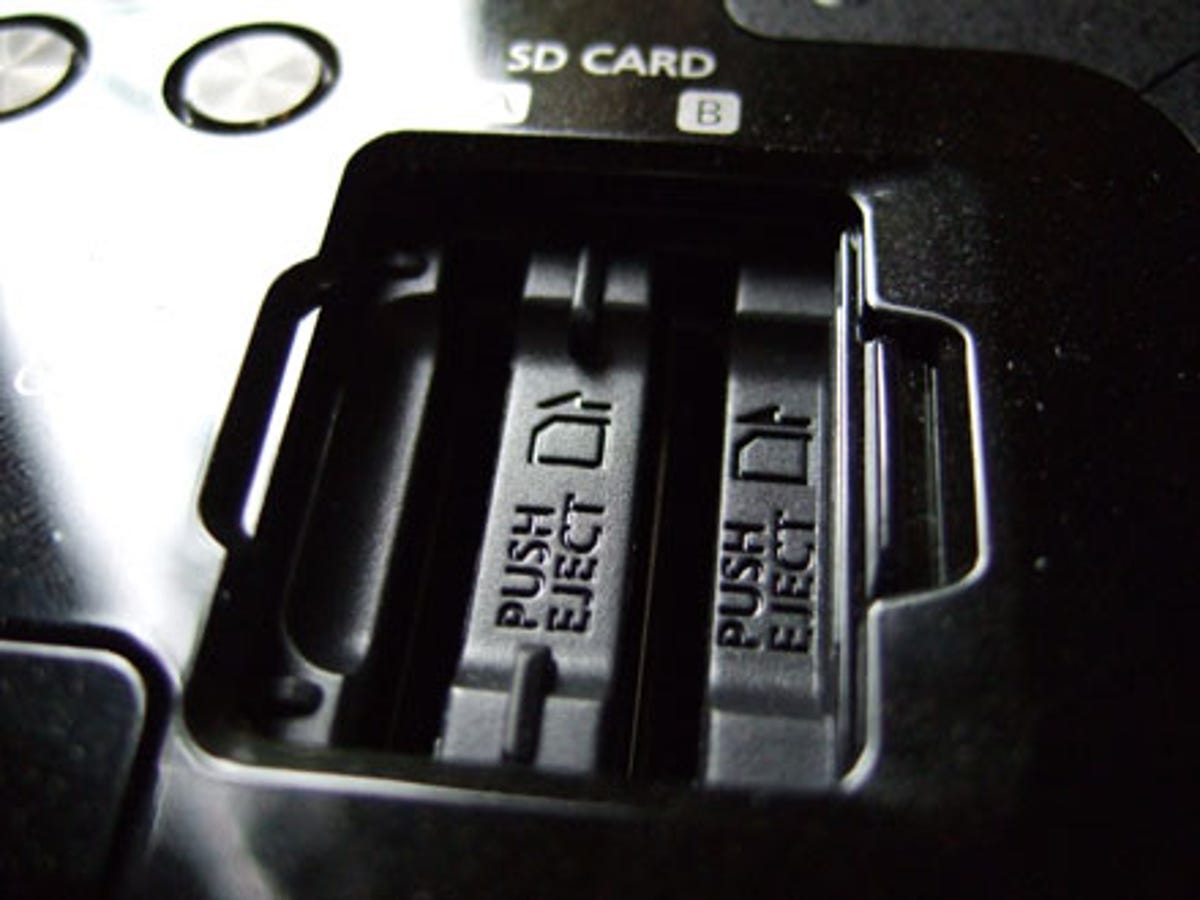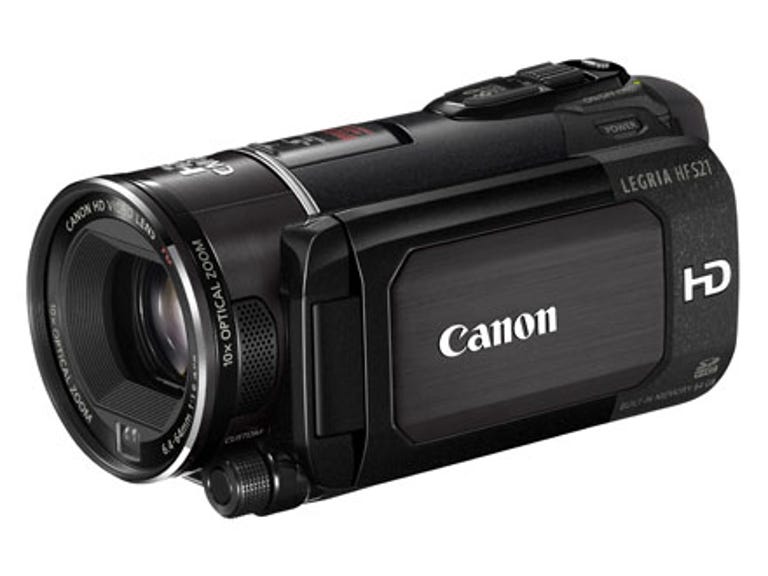 Why You Can Trust CNET
Why You Can Trust CNET Canon Legria HF S21 review: Canon Legria HF S21
The Canon Legria HF S21 sets new standards for home-video image quality. The camcorder is large, expensive and complicated to use, but if you're after the best, you're unlikely to hold any of these factors against it.
At the very pinnacle of Canon's consumer range sits the Legria HF S21. This fully fleshed-out camcorder is effectively the last stop on the road towards the manufacturer's broadcast-standard models. Clocking in at nearly half a kilo, the HF S21 is a more heavyweight prospect than many other home video cams, in more ways than one. Its manual control options and £1,000 price tag put it firmly in the 'enthusiast' bracket.
The Good
The Bad
The Bottom Line
The incredible hulk
Let's just say the HF S21 is not particularly small. Or light, for that matter. It's by no means the type of shoulder-mounted behemoth you see local news crews carting around but, by the same token, it's probably the least palm-friendly consumer camcorder we've seen for a while. You're going to want to invest in a decent carry case to go with this one.
The Legria's chunkier proportions can be attributed, in part, to the sizeable 3.5-inch fold-out LCD display. Not only is it vast (compared to screens found on most other models), but it's also extremely high-resolution, with 922k pixels providing almost Full HD resolution for monitoring and playback.
Also adding to the HF S21's bulk is its 64GB of built-in storage. This is generous in anyone's books, and Canon goes one further by providing the option of adding not just one, but two additional SD memory cards. With a pair of 32GB SDHC cards, this would allow you to potentially double the device's storage capacity, while the Relay Recording feature automatically detects when one storage medium is full and switches to the other.

Two SD card slots is a great idea, although, sadly, the HF S21 doesn't support the newer, higher capacity SDXC format, which means a total of 128GB is currently your absolute upper limit. We say 'currently' because we've noticed that, in some territories, Canon has made a firmware update available, which potentially fixes the SDXC-compatibility problem. Canon UK doesn't yet offer the update and we don't recommend you download it from another country's website.
Barrel of fun
We're guessing that most of the HF S21's size and heft can be put down to the device's optics. A large, high-quality Canon HD video lens has a defining influence over the barrel shape of the unit. 10x optical magnification is provided by the zoom, and this can be boosted further without degrading the image using Canon's 1.7x Digital Tele-Converter, which employs otherwise unused pixels on the 8.59-megapixel sensor for a kind of faux zoom effect. A 'proper' optical image stabiliser (OIS) is included. The OIS has a dynamic mode, which can provide a little extra steadiness in times of need. It is also supported by Powered IS, which does a surprisingly good job of steadying your shots when you're filming at the telephoto end of the zoom.
Despite the presence of Canon's simplified Dual Shot mode, for those who want to indulge in fully automatic point-and-shoot operation, this is clearly an enthusiast's camera, with all the manual features that high-end users require. The HF S21 provides full control over exposure, aperture, focus and so on, either via the touch-sensitive screen or the handy context-sensitive control dial below the lens. The latter isn't quite as good as a lens ring (like the one you'll find on Panasonic's HDC-TM700), but it's still a great tool for those who need an effective way of fine-tuning their shots.
We'd go so far as to suggest you may eventually find yourself using the on-screen controls as well as -- or even instead of -- the hardware dial. We tried both methods during our tests and, though we initially felt more comfortable with the dial, we began favouring the touchscreen equivalents a little more once we got used to them.
The touch-sensitive interface is essentially the same one that has infuriated us in the past on Canon's lower-end models, such as the HF M31. Here, however, the control system is much more usable, largely due to the simple fact that the screen itself is much bigger. We still had some issues with its responsiveness, but on a larger display it's much easier to hit the right options with your fingertips, while touch and swipe-based modes, such as Touch Tracking, Touch Focus and Touch Exposure all make much more sense too.
Most of the other boxes on enthusiast checklists are ticked off, too, including an input for external microphones and a headphone output for monitoring audio. HDMI, component, USB and standard AV round out the other connections. The 58mm lens thread is compatible with many professional filters and adaptors. An accessory shoe is available for attaching other add-ons (though it only works with Canon-branded kit) and there's even a colour viewfinder for expert framing and composition.
Mos (high) def
The most important element for experts, however, is image quality and, in this regard, the HF S21 doesn't fall short. The device has five video-recording modes, two of which film in 1080p interlaced high-definition at 50 frames per second (fps), while the other three record at a slightly lower resolution of 1440x1080 pixels. Bit rates range from just 5Mbps at the lowest setting, right up to 24Mbps, which is the highest quality the AVCHD standard allows.
Recording at the top-end mode provides simply astonishing results: silky smooth motion combined with vibrant colours and hyper-realistic detail. Skin tones are pleasantly reproduced, too and, apart from anything, it's possible to achieve some stunning depth-of-field photography, throwing your subjects into sharp focus while blurring out the background. Techniques like these just aren't possible to any degree of effectiveness with most consumer models, and help to elevate your footage to near-professional quality. It helps if you know what you're doing, though. Our auto-mode tests produced some fine video, but it wasn't until we flipped the safetys off and started to tweak and tinker with the manual controls that we truly unlocked the Legria's potential.
Still photos can be good, too, but again, those with more advanced camera skills will be best equipped to make the most of what the HF S21 has to offer. The Legria takes un-interpolated stills at up to 8 megapixels. It's possible to take snaps during filming, though results are better in the dedicated photo mode. We found colours could look a little off in certain conditions, particularly if you have left the unit in full auto mode.
Indoors, the HF S21 is one of the better camcorders we've seen. It has just one large CMOS so, theoretically, it's not quite as capable in low-light conditions as devices that use three separate image sensors, but it's really not far off the competition. You can aid performance in low light by switching to the 25fps progressive mode. Motion isn't as smooth, but the lower shutter speed helps to brighten the image with minimum impact.
Start saving
We won't pretend the HF S21 is perfect. For example, it doesn't feature a 1080p/50fps progressive mode, which you can now find on many of Panasonic's top-end offerings. It's also somewhat cumbersome, its design and heft making it feel a throwback to a more primitive era of consumer electronics. If you're anything like us, you may find the touchscreen annoying to use at first -- though this does get easier with practice, trust us.
Conclusion
For enthusiasts who really want to push the limits of what you can achieve with a home video device, it probably comes down to a choice between this and the aforementioned Panasonic HDC-TM700. Both have their pros and cons but, for our money, the HF S21 provides the opportunity to take some truly remarkable footage. In saying that, you have to work hard to achieve the best results, and even the most enthusiastic of enthusiasts may flinch at this flagship product's premium price tag.
Edited by Emma Bayly


